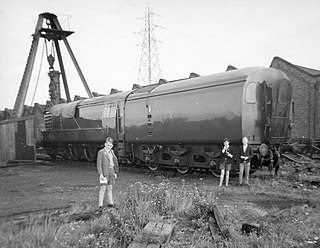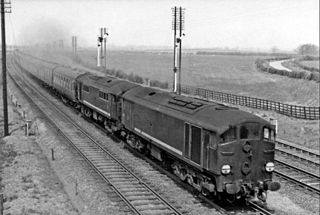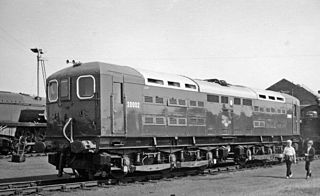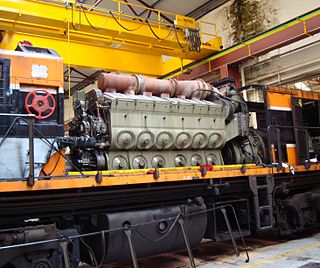
A locomotive or engine is a rail transport vehicle that provides the motive power for a train. If a locomotive is capable of carrying a payload, it is usually rather referred to as a multiple unit, motor coach, railcar or power car; the use of these self-propelled vehicles is increasingly common for passenger trains, but rare for freight trains.

A diesel locomotive is a type of railway locomotive in which the power source is a diesel engine. Several types of diesel locomotives have been developed, differing mainly in the means by which mechanical power is conveyed to the driving wheels. The most common are diesel-electric locomotives and diesel-hydraulic.

D0280 Falcon was a single prototype diesel-electric locomotive, built for British Railways in 1961. It was one of a series of three prototypes: Falcon, DP2 and Lion, eventually leading to the Class 47 and Class 50. A requirement was expressed by the BTC at a meeting on 15 January 1960 for new Type 4 designs of Co-Co arrangement, which would be lighter than the earlier 1Co-Co1 locomotives such as the Peak classes, produced under the Pilot Scheme.

The British Rail Class 89 is a prototype electric locomotive. Only one was built, in 1986, by British Rail Engineering Limited's Crewe Works. It was used on test-trains on both the West Coast and East Coast Main Lines. The locomotive was fitted with advanced power control systems and developed more than 6,000 bhp. After being withdrawn in 1992, it was returned to service in 1996, before being again withdrawn in 2000. As of January 2021, it is in the final stages of an overhaul that will return it to the main line.

HS4000 Kestrel was a prototype high-powered mainline diesel locomotive that was built in 1967 by Brush Traction, Loughborough, as a technology demonstrator for potential future British Rail and export orders. The locomotive number is a combination of the initials of Hawker Siddeley and the power rating of its Sulzer diesel engine (4,000 hp), making it the most powerful locomotive built by the company.

GT3 was a prototype mainline gas turbine locomotive built in 1961 by English Electric at its Vulcan Foundry in Newton-le-Willows to investigate the use of its gas turbines in rail traction applications. It followed 18000 and 18100 as gas turbines 1 and 2. It was designed by English Electric engineer J. O. P. Hughes in a project that started in the early 1950s. Externally it resembled a steam tender locomotive, but the tender carried kerosene fuel. The designer said the traditional chassis and mechanical transmission avoided complications with relatively untried technologies for bogies and electrical transmission.

British Rail 18000 was a prototype mainline gas turbine-electric locomotive built for British Railways in 1949 by Brown, Boveri & Cie. An earlier gas-turbine locomotive, 18100, had been ordered from Metropolitan-Vickers by the Great Western Railway but construction was delayed due to World War II; a second, 18000, was thus ordered from Switzerland in 1946. It spent its working life on the Western Region of British Railways, operating express passenger services from Paddington station, London.

Class 80 was the TOPS classification allocated by British Rail to the prototype 25 kV AC electric locomotive. This locomotive was built by Metropolitan-Vickers, initially as a prototype gas turbine-electric locomotive, numbered 18100. British Rail allocated the number E1000 to the locomotive following its conversion from gas turbine propulsion.
Metropolitan-Vickers, Metrovick, or Metrovicks, was a British heavy electrical engineering company of the early-to-mid 20th century formerly known as British Westinghouse. Highly diversified, it was particularly well known for its industrial electrical equipment such as generators, steam turbines, switchgear, transformers, electronics and railway traction equipment. Metrovick holds a place in history as the builders of the first commercial transistor computer, the Metrovick 950, and the first British axial-flow jet engine, the Metropolitan-Vickers F.2. Its factory in Trafford Park, Manchester, was for most of the 20th century one of the biggest and most important heavy engineering facilities in Britain and the world.

The British Rail Class 28 diesel-electric locomotives, known variously as 'Metrovicks', 'Crossleys' or 'Co-Bos', were built under the Pilot Scheme for diesel locomotives as part of the British Railways 1955 Modernisation Plan.

A gas turbine locomotive is a type of railway locomotive in which the prime mover is a gas turbine. Several types of gas turbine locomotive have been developed, differing mainly in the means by which mechanical power is conveyed to the driving wheels (drivers). A gas turbine train typically consists of two power cars, and one or more intermediate passenger cars.

The British Rail Class 25, also known as the Sulzer Type 2, is a class of 327 diesel locomotives built between 1961 and 1967 for British Rail. They were numbered in two series, D5151–D5299 and D7500–D7677.

The British Rail Class 70 was a class of three third rail Co-Co electric locomotives. The initial two were built by the Southern Railway (SR) at Ashford Works in 1940–41 and 1945 and were numbered CC1 and CC2 - the Southern Railway latterly preferring French practice for locomotive numbers which also gave an indication of the wheel arrangement. Electrical equipment was designed by Alfred Raworth and the body and bogies by Oliver Bulleid. CC2 was modified slightly from the original design by C. M. Cock who had succeeded Raworth as electrical engineer. The third was built by British Railways in 1948 and numbered 20003.

LMS No. 10000 and 10001 were some of the first mainline diesel locomotives built in Great Britain. They were built in association with English Electric by the London, Midland and Scottish Railway at its Derby Works, using an English Electric 1,600 hp diesel engine, generator and electrics.

British Railways 10800 was a diesel locomotive built by the North British Locomotive Company for British Railways in 1950. It had been ordered by the London, Midland and Scottish Railway in 1946 but did not appear until after the 1948 nationalisation of the railways.

Am 4/6 1101 was the world's first gas turbine-electric locomotive. The locomotive was ordered by the Swiss Federal Railways (SBB-CFF-FFS) from the Swiss Locomotive and Machine Works (SLM) and Brown, Boveri & Cie (BBC) in 1939. The locomotive was delivered in 1941 and was in use on railroads in Switzerland, France and Germany until 1954.
Bowesfield Works was a railway locomotive manufacturing plant in Stockton-on-Tees. The works was operated by a joint venture company called Metropolitan Vickers-Beyer Peacock from 1949 until 1960.

In engineering, a prime mover is an engine that converts chemical energy of a fuel into useful work. In a locomotive, the prime mover is thus the source of power for its propulsion. In an engine-generator set, the engine is the prime mover, as distinct from the generator.

The South African Railways gas-electric locomotive of 1923 was an experimental gas-electric locomotive. The fuel, suction gas, was generated on-board the locomotive from coal.

An internal combustion locomotive is a type of railway locomotive that produces its pulling power using an internal combustion engine. These locomotives are fuelled by burning fossil fuels, most commonly oil or gasoline, to produce rotational power which is transmitted to the locomotive's driving wheels by various direct or indirect transmission mechanisms. The fuel is carried on the locomotive.



















